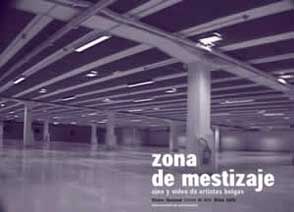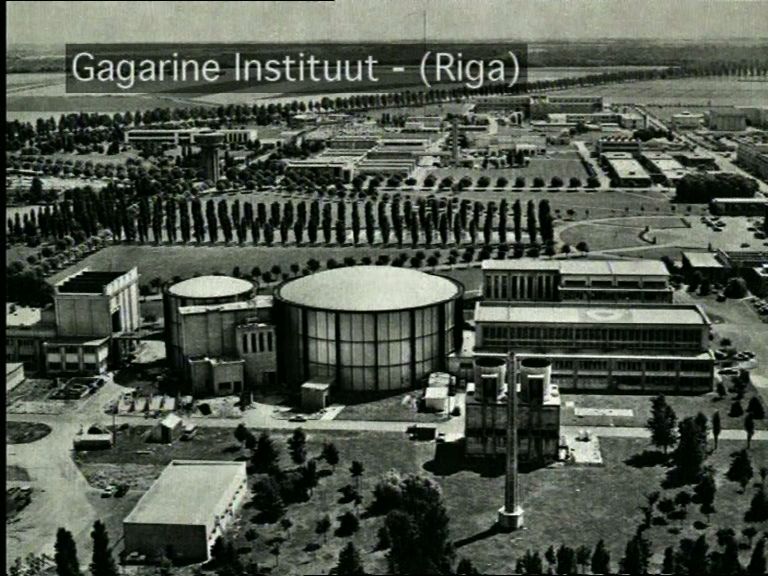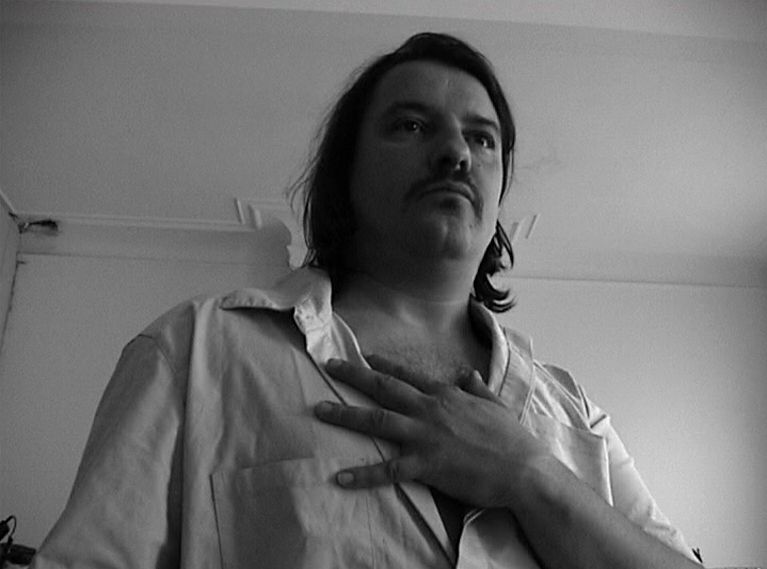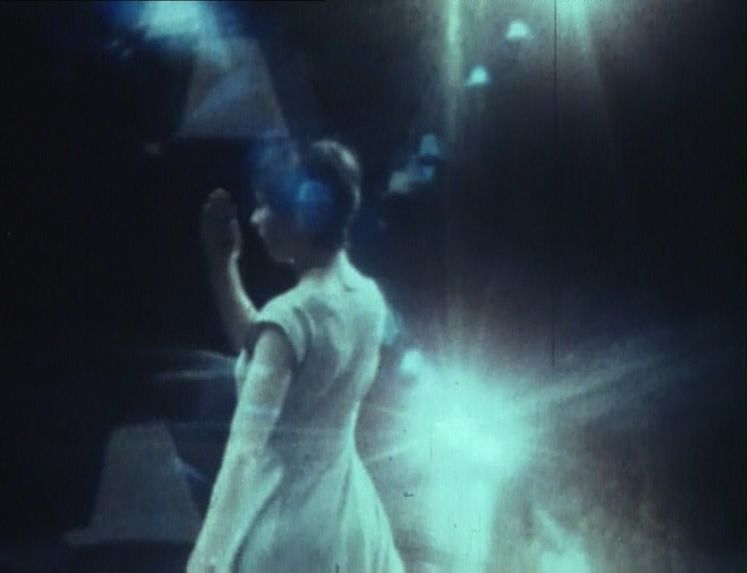16.09.04—30.09.04
Location:
Museo Nacional de arte Reina Sofia
Zona de mestizaje - Cine y Vídeo de Artistas Belgas
screening

Copyright artist(s) and courtesy argos
The Audiovisual departement of the Reina Sofia Arts Centre invited argos to compose a programme of Belgian artist’s video- and filmwork. Zona De Mestizaje - ’a zone of cross-overs’ - testifies to a hybrid scene where the most diverse forms, approaches or strategies meet, resulting in a rather surreal combination of colours and aromas, radical positions and simple statements .The programme, out of sheer necessity merely a small cross section from thousands of titles, illustrates the particular, inalienable universe each of the artists represents. Eclecticism and a multitude of crossovers with other disciplines are typical characteristics. With their interpretation of The Walkyrie the Theys brothers modernize the Wagnerian Gesammtkunstwerk. With his culture-critical essayist-documentary work Stefaan Decostere operates like a Trojan horse within the mass medium of television. In the relationship between the camera and dance as a subject matter Thierry De Mey, Eric Pauwels or Antonin de Bemels seek out the potential to disrupt aesthetic boundaries. Other artists relate themselves to the performance tradition in visual artists, with architecture and urbanism or innovative genres like the cinematic letter or the documentary, also by intelligently undermining of withered codes. Because they stand out with their imaginative ideas and their zest to create unconventional work with a personal ’handwriting’, Belgian artists’ film and video makers have created their own free zone. In a (media) world where experiences are increasingly formatted and popularised, there is a need for these types of singularities, for a healthy dose of nomadicity. And that is what these artists stand for.
Brussels Topologies (81’16”)
This work is a formally and stylistically diverse exploration of the architecturally heterogenic dissonant Belgian capital. The centre and its outskirts, above ground and below, even a government administration office and a hypermarket are explored.
Michel Lorand. Installation #3. 2002, color, 7’20”
Philippe Van Damme. Rue de l’Avenir. 1993, color, 8’39”
Hans Op de Beeck. Situation. 2000, color, 1’30”
Jan Kempenaers. Strombeek . 2000, color, 15’ excerpt of 50’
Sarah Vanagt. Little Figures. 2003, color & b/w, English spoken, 15’47”
Sven Augustijnen & Barbara Visser. De kunstberg. 2000, color, 14’23”
Peter Downsbrough. Occupied. 2000, b/w, 18’37”
The Fiction of Reality (91’26”)
Three films roguishly question documentary codes. The boundaries between the real and the unreal are blurred; facts are represented as fiction and fiction as factual. Stories, anyway, all the way down.
Stephane Aubier, Vincent Patar, Vincent Tavier. Ufo’s boven Geel. 1999, color & b/w, Dutch and French spoken, 12’
Bram Van Paesschen. Rookgordijn boven Brussel (het inno-dossier heropend). Dutch and French spoken, 2002, color & b/w, 35’15”
Sven Augustijnen. Le guide du parc. 2001, color, French spoken, 44’11”
Joëlle Tuerlinckx - ÉTUDES AMERICAINES CHICAGO CLEVELAND NEW YORK 2003 SPACE THESES PARTS 1-5 (WINTER 1, WINTER 2, SUMMER 1, SUMMER 2, FALL 1)
Two 40’ ‘performed’ fragments live by the artist, assisted by Jos De Gruyter, like a musical score based on five hours of video images and sounds.
Five spatial propositions structure their data information as a video film ‘with special effects in black-and-white’, with off-chance takes, at the outset of what is imposed on us from reality by the image. In ‘Études Américaines’ the subject is ‘assumed’, presented from all sides to the eye of the camera. As one hand is filming, the other is measuring out, evaluating, considering: the duration of a shot, the distance to the subject, daylight. It is reading the object. (Joëlle Tuerlinckx)
Stefaan Decostere - Travelogues (67’05”)
Two segments from the five part The Travelogue Series, exploring parallels between different forms of cultural display: the museum, the world fair; the city, film, television, the shopping mall and the tourist site.
Travelogue 3: Alchemy Bruxelloise. 1990, color & b/w, French and Dutch spoken, 12’50”
Travelogue 5: Déjà-Vu. 1994, color, French, Dutch and English spoken, 54’15”
Dance and Camera (70’)
The fusion or contest between dance and film/video challenges existing notions of choreography, spectatorship, the dancing body and film/video as a context for dance.
Eric Pauwels. Violin Fase. 1986, color, 11’44”
Eric Pauwels. Trois danses hongroises de Brahms. 1990, color, 9’17”
Antonin de Bemels. Scrub solo 1: Soloneliness. 1999, b/w, 8’30
Tom Barman. Turnpike. 1997, color, 5’12”
Thierry De Mey. 21 Etudes à danser. 1999, color, 23’51”
Jan Vromman. Gent, 10 Juni 1989, voor Geraldine Nerea. 1989, color, 5’03”
Walter Verdin. Monoloog van Fumyo Ikeda of het einde van Ottone, Ottone. 1989, b/w, 6’23”
Koen & Frank Theys - De Walkure
An allegory on mass culture and mass media inspired by Richard Wagner’s The Walkyrie, this exuberant parade of electronic settings, inflatable females, sham rustic, scale models, aestheticizes images into an abysmal game with perspective and space.
De Walkure. 1989, color, 85’
Body Scenes (64’01”)
Different approaches to the body, in most cases with the artist featuring before the camera: physical effort, instability, stop motion, absurd action, ‘self-portrayal’ and more.
Emilio López-Menchero. Trying to be Balzac. 2002, b/w, 6’31”
Cel Crabeels. Topologic. 2002, color, 13’30”
Messieurs Delmotte. Ce qui est fait le mal est fait. 1998, color, 4’02”
Michel François. Autoportrait contre nature. 2001, color, 11’52”
Claude Cattelain. Echelle et adhésif, Patatras,Variations avec bois, tabourets et adhésif quelques fois. 2002, color, 6’07”
Ana Torfs & Jana Sterbak. Condition. 1995, b/w, 7’53”
Frank Theys. Self-Portrait. 2002, color, 3’16”
Pascal Baes. Tsumi (The Mis-step). 1993-1998, color, 10’50”
Eric Pauwels - Film Letters (56’40”)
In this short tribute to French filmmaker Jean Rouch and a personal film addressed by the filmmaker to his daughter, Pauwels philosophises both times about the essence of cinema and consequently life.
Lettre à Jean Rouch. 1993, black & white, French spoken, 6’40”
Lettre d’un cinéaste à sa fille. 2000, color & b/w, French spoken, 50’00”
Brussels Topologies (81’16”)
This work is a formally and stylistically diverse exploration of the architecturally heterogenic dissonant Belgian capital. The centre and its outskirts, above ground and below, even a government administration office and a hypermarket are explored.
Michel Lorand. Installation #3. 2002, color, 7’20”
Philippe Van Damme. Rue de l’Avenir. 1993, color, 8’39”
Hans Op de Beeck. Situation. 2000, color, 1’30”
Jan Kempenaers. Strombeek . 2000, color, 15’ excerpt of 50’
Sarah Vanagt. Little Figures. 2003, color & b/w, English spoken, 15’47”
Sven Augustijnen & Barbara Visser. De kunstberg. 2000, color, 14’23”
Peter Downsbrough. Occupied. 2000, b/w, 18’37”
The Fiction of Reality (91’26”)
Three films roguishly question documentary codes. The boundaries between the real and the unreal are blurred; facts are represented as fiction and fiction as factual. Stories, anyway, all the way down.
Stephane Aubier, Vincent Patar, Vincent Tavier. Ufo’s boven Geel. 1999, color & b/w, Dutch and French spoken, 12’
Bram Van Paesschen. Rookgordijn boven Brussel (het inno-dossier heropend). Dutch and French spoken, 2002, color & b/w, 35’15”
Sven Augustijnen. Le guide du parc. 2001, color, French spoken, 44’11”
Joëlle Tuerlinckx - ÉTUDES AMERICAINES CHICAGO CLEVELAND NEW YORK 2003 SPACE THESES PARTS 1-5 (WINTER 1, WINTER 2, SUMMER 1, SUMMER 2, FALL 1)
Two 40’ ‘performed’ fragments live by the artist, assisted by Jos De Gruyter, like a musical score based on five hours of video images and sounds.
Five spatial propositions structure their data information as a video film ‘with special effects in black-and-white’, with off-chance takes, at the outset of what is imposed on us from reality by the image. In ‘Études Américaines’ the subject is ‘assumed’, presented from all sides to the eye of the camera. As one hand is filming, the other is measuring out, evaluating, considering: the duration of a shot, the distance to the subject, daylight. It is reading the object. (Joëlle Tuerlinckx)
Stefaan Decostere - Travelogues (67’05”)
Two segments from the five part The Travelogue Series, exploring parallels between different forms of cultural display: the museum, the world fair; the city, film, television, the shopping mall and the tourist site.
Travelogue 3: Alchemy Bruxelloise. 1990, color & b/w, French and Dutch spoken, 12’50”
Travelogue 5: Déjà-Vu. 1994, color, French, Dutch and English spoken, 54’15”
Dance and Camera (70’)
The fusion or contest between dance and film/video challenges existing notions of choreography, spectatorship, the dancing body and film/video as a context for dance.
Eric Pauwels. Violin Fase. 1986, color, 11’44”
Eric Pauwels. Trois danses hongroises de Brahms. 1990, color, 9’17”
Antonin de Bemels. Scrub solo 1: Soloneliness. 1999, b/w, 8’30
Tom Barman. Turnpike. 1997, color, 5’12”
Thierry De Mey. 21 Etudes à danser. 1999, color, 23’51”
Jan Vromman. Gent, 10 Juni 1989, voor Geraldine Nerea. 1989, color, 5’03”
Walter Verdin. Monoloog van Fumyo Ikeda of het einde van Ottone, Ottone. 1989, b/w, 6’23”
Koen & Frank Theys - De Walkure
An allegory on mass culture and mass media inspired by Richard Wagner’s The Walkyrie, this exuberant parade of electronic settings, inflatable females, sham rustic, scale models, aestheticizes images into an abysmal game with perspective and space.
De Walkure. 1989, color, 85’
Body Scenes (64’01”)
Different approaches to the body, in most cases with the artist featuring before the camera: physical effort, instability, stop motion, absurd action, ‘self-portrayal’ and more.
Emilio López-Menchero. Trying to be Balzac. 2002, b/w, 6’31”
Cel Crabeels. Topologic. 2002, color, 13’30”
Messieurs Delmotte. Ce qui est fait le mal est fait. 1998, color, 4’02”
Michel François. Autoportrait contre nature. 2001, color, 11’52”
Claude Cattelain. Echelle et adhésif, Patatras,Variations avec bois, tabourets et adhésif quelques fois. 2002, color, 6’07”
Ana Torfs & Jana Sterbak. Condition. 1995, b/w, 7’53”
Frank Theys. Self-Portrait. 2002, color, 3’16”
Pascal Baes. Tsumi (The Mis-step). 1993-1998, color, 10’50”
Eric Pauwels - Film Letters (56’40”)
In this short tribute to French filmmaker Jean Rouch and a personal film addressed by the filmmaker to his daughter, Pauwels philosophises both times about the essence of cinema and consequently life.
Lettre à Jean Rouch. 1993, black & white, French spoken, 6’40”
Lettre d’un cinéaste à sa fille. 2000, color & b/w, French spoken, 50’00”
Location:
Reina Sofia Art Centre
Santa Isabel 52
28012 Madrid
Reina Sofia Art Centre
Santa Isabel 52
28012 Madrid



